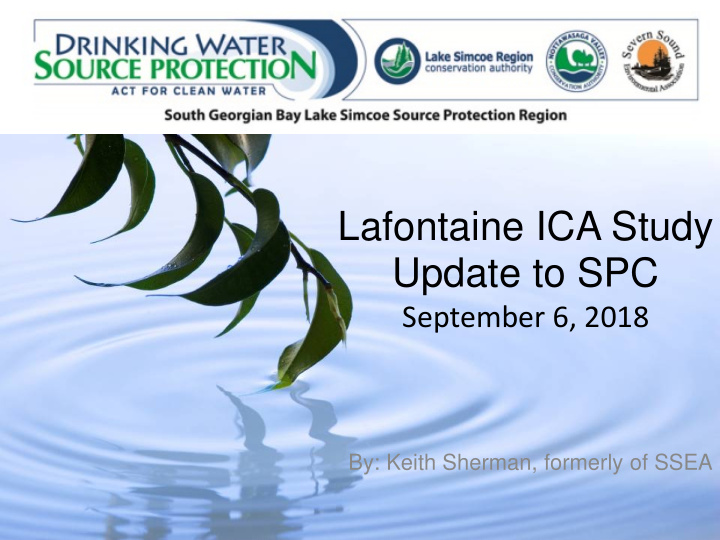



Lafontaine ICA Study Update to SPC September 6, 2018 By: Keith Sherman, formerly of SSEA
Lafontaine - ICA for Nitrate concentration
Integrated surface/groundwater model
Integrated surface/groundwater model
Lafontaine – Supplementary ICAs for Nitrate concentration Data sources: SSSPA AR ICA boundary; Golder Associates modelled boundaries; Simcoe County 2016 ortho photo
Municipal well monitoring results
Municipal well monitoring results (Lafontaine 23-1 and 23-4)
Key findings of study components: Wells Trends in municipal production wells continue to rise, latest NO ₃ results for • LA wells >12 mg/L – LA wells may be leveling off, GS wells (PH2&PH14) may be increasing • SSEA 2015 surveyed wells in study area, 25+ wells sampled for EC/U Waterloo analysis, SSEA surveyed private wells usage • Some wells may represent “transport pathways” due to substandard construction NO ₃ concentration in wells sampled ranged from <0.07 to >10 mg/L – results • compared to earlier survey by Golder Associates MOECC and HU regulate communal private wells elevated >10 mg/L – NO ₃ • trends in these wells also rising with closest private supply well to LA wells leveling off • Four private well owners informed of >10 mg/L jointly by HU and SSEA with general NO ₃ info, all owners provided results
Key findings of study components: Agricultural fields • Agricultural fields represent 80% of the ICA • Golder 2016 Report “primary source of nitrate to the municipal wells stems from agricultural field runoff and subsequent infiltration occurring up to several kilometres upgradient of the wells” • CCA interviews: 9 farming operations account for the majority of fields in the study area only one farmer did not participate (52 fields, 342 “field years” 2013-2015) • CCA analysis: estimated nitrogen loss to the groundwater (38 lb/ac/yr or 42.6 kg/ha/yr) • CCA recommended best management practices for agricultural operations, supplemented with measures from Risk Management Measures Catalogue and OFEC Farm Source Water Protection Framework to be considered in RMPs
Key findings of study components: On-site sewage systems • All private septic systems in the study area have been inspected by the Township of Tiny contractor – overall ~12% of systems require follow-up abatement, ongoing • EC/U of Waterloo preliminary isotope/sweetener analyses showed “major source of the groundwater nitrate is likely nitrified synthetic fertilizers”, “Septics are not a major nutrient source in study area” • Golder 2017 evaluation of Lafontaine capture zone septics indicates not sufficient to account for the well concentrations • Recommendation for new or updated commercial septic systems to implement enhanced tertiary systems with nitrogen removal
Potential Risk Management Measures – fertilizer application on fields • Maintenance and calibration of equipment • Minimize erosion • Enhancing On-Farm Denitrification: Alternate cropping systems • Variable Rate Application on each field • Grassed waterways where appropriate • Balanced application of nitrogen to crop – “4Rs” • Restrict timing of application in late fall/early spring or when rainfall predicted or when tiles running • Split application using pre-established target yield • Record keeping – crop rotation, soil testing, application rates, yield • Contingency plan and training • First signed RMP issued August 1, 2018
When can we expect a response to RMPs?
Lafontaine ICA Implementation First RMP signed by farm operator in the ICA implementing BMPs to manage nitrogen loss to the aquifer
Lafontaine ICA Implementation Septic upgrade needed at this commercial property – a tertiary system was installed to expand capacity and maintain the same nitrate loading
Next Steps • Risk Management Measures including recommended BMPs will be negotiated with each operator – RMP for each operator (9) with “schedule” of properties to be attached for each year • Explore incentive funding for implementation • Township to continue to monitor trends • Final summary report bringing all components together as input to the next update of the AR
Study Partners • SGBLS SP Region • Andy van Niekerk, P.Ag., CCA-ON • John Spoestra, Environment Canada and Climate Change/University of Waterloo • Devin Hannan, P.Eng., John Easton, M.Sc.,P.Geo, Golder Associates Ltd. • Pierre-Paul Maurice, Monpiero Farms • Dave Randall, Marie Richardson, Rebecca Sackrider, Township of Tiny
Recommend
More recommend